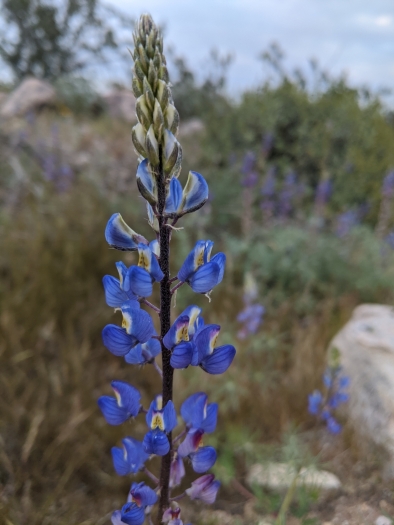Coulter’s Lupine
(Lupinus sparsiflorus)
Coulter’s Lupine (Lupinus sparsiflorus)
/
/

Rachel Stringham
CC BY 4.0
Image By:
Rachel Stringham
Recorded By:
Copyright:
CC BY 4.0
Copyright Notice:
Photo by: Rachel Stringham | License Type: CC BY 4.0 | License URL: http://creativecommons.org/licenses/by/4.0/ | Rights Holder: Rachel Stringham | Publisher: iNaturalist | Date Created: 2020-02-28T18:09:28-08:00 |



























































Estimated Native Range
Summary
Lupinus sparsiflorus, commonly known as Coulter’s Lupine, is an annual herb that is native to the desert regions and chaparral and scrub areas of the Southwestern USA and Northwest Mexico. It typically grows to a height of 20 to 40 centimeters. The plant features palmate leaves with 7 to 11 very narrow leaflets, each up to 3 centimeters long and a few millimeters wide. The inflorescence is a spiral cluster of several flowers, each about a centimeter long. The flowers are initially blue or purple, darkening with age, and feature a distinctive white to pink patch on the banner, making them quite showy in the spring and early summer months.
Coulter’s Lupine is valued for its vibrant flowers and ability to thrive in arid conditions, making it a suitable choice for xeriscaping and wildflower gardens. It is often used for naturalizing in dry, open areas and can contribute to soil enrichment through its nitrogen-fixing capabilities. This lupine prefers full sun exposure and requires minimal water once established, making it a low-maintenance option for gardeners. It is adapted to soils with medium drainage and can tolerate poor, sandy soils. While generally disease-free, it can be susceptible to fungal problems in overly moist conditions.CC BY-SA 4.0
Coulter’s Lupine is valued for its vibrant flowers and ability to thrive in arid conditions, making it a suitable choice for xeriscaping and wildflower gardens. It is often used for naturalizing in dry, open areas and can contribute to soil enrichment through its nitrogen-fixing capabilities. This lupine prefers full sun exposure and requires minimal water once established, making it a low-maintenance option for gardeners. It is adapted to soils with medium drainage and can tolerate poor, sandy soils. While generally disease-free, it can be susceptible to fungal problems in overly moist conditions.CC BY-SA 4.0
Plant Description
- Plant Type: Herb
- Height: 0.3-0.7 feet
- Width: 0.5-1 feet
- Growth Rate: Moderate
- Flower Color: Blue, Purple
- Flowering Season: Spring
- Leaf Retention:
Growth Requirements
- Sun: Full Sun
- Water: Low
- Drainage: Medium
Common Uses
Bee Garden, Bird Garden, Butterfly Garden, Deer Resistant, Drought Tolerant, Groundcover, Hummingbird Garden, Low Maintenance, Rabbit Resistant, Showy Flowers
Natural Habitat
Native to desert regions and chaparral and scrub areas of the Southwestern USA and Northwest Mexico
Other Names
Common Names: Mojave Lupine
Scientific Names: Lupinus sparsiflorus , Lupinus sparsiflorus var. sparsiflorus , Lupinus sparsiflorus var. inopinatus
GBIF Accepted Name: Lupinus sparsiflorus Benth.